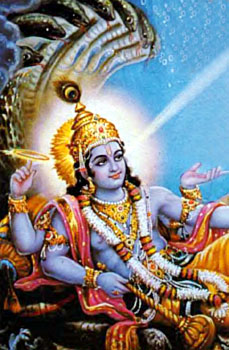 Vishnu Purana says that Lord Brahma has the power of creation. Even Lord Vishnu is produced by the Lord God. The Lord has set a measure for human life. According to the measure set it is believed that human life is composed of hundred years. Vishnu Purana has described in detail the division of time in human life.
Vishnu Purana says that Lord Brahma has the power of creation. Even Lord Vishnu is produced by the Lord God. The Lord has set a measure for human life. According to the measure set it is believed that human life is composed of hundred years. Vishnu Purana has described in detail the division of time in human life.
Vishnu Purana states that time form of human life is similar to the Time-Form of Lord Vishnu. The Lord has described the time form in human life in relation to the God Himself, human beings, other creatures, and seas, mobile and immobile objects as well. The Lord says that a kastha is composed of fifteen nimeshas. Thirty kasthas make up a kala; and thirty kalas make up a muhurto. Similarly thirty muhurtas make up a day and a night for a human being. Thirty days on the other hand add up to a month. Rather said in a better manner a month has thirty days in it. A month also has two fortnights.
It has been said that six months form an ayana; and a year is composed of two ayanas, one northern and the other southern. The southern ayana is the night of the celestials, and the northern is their day. Discussing about the divisions of time it has been said that the period of twelve thousand years of the deities constitute the four Yugas, viz., Krita, Treta, and the others. About the four Yugas it has been said that four, threes two and one thousand divine years successively compose Krita and the other Yogas. A hundred divine years are said to constitute the first twilight, as another hundred years the last part of the Yuga. Vishnu Purana says that the space that intervenes between the twilights is known as the Yuga. Accordingly the four Yugas namely Krita, Treta, Dwarpa and Kali and the rest are formed in human life.
The division of time is such that one day of Lord Brahma comprises four and ten reigns of the Manus. Vishnu Purana describes the seven saints, the celestials, Sakra, Manu, and his sons` kings; all of them are created at the same time and are destroyed at the same time. On the other hand a little more than seventy one Yuga constitute a Manwantra- the period of Manus as well as other gods. Manwanta takes up over eight lakshas and fifty-two thousand years. Ten and fourteen such periods form one day of Brahma. Finally after this comes on his sleep and at the end the universal dissolution comes in. Finally the entire triune world, comprising Bhur, Bhuva and the rest, are in conflagration, and the dwellers of the regions of Maha, exercised with the heat, resort to the regions of Jana. It has been said that when the three regions are reduced to one sheet of sea Narayana lies down on the bed formed by the serpent to swallow the three worlds.
It is then that having spent the might measuring that period; at the end thereof he begins anew the work of creation. This is called the year of Brahma and this is the space of his hundred years. As Lord Brahma passes away it is said that passes a Mahakalpa which is called Padma.



















